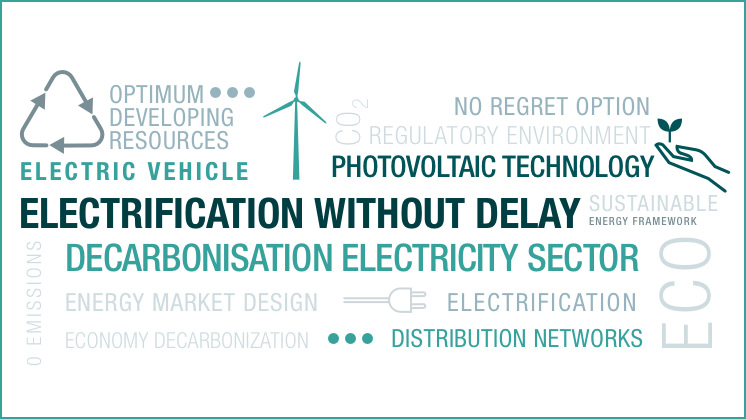Decarbonisation
What is decarbonization? Regulatory principles and actions relating to energy decarbonisation that contribute to a sustainable and efficient framework to fight climate change
Decarbonisation Energy transition
Climate change is today's greatest environmental challenge, and social concern about it grows year by year. The 2015 Paris Agreement was a decisive move to action, since 195 nations approved the limiting of the increase in global temperature to 2 ºC by the end of the century compared to pre-industrial levels and the pursuance of efforts to reduce it to 1.5 ºC.

What is decarbonisation?
Decarbonisation is the process of reducing the amount of carbon, mainly carbon dioxide (CO2), sent into the atmosphere. Its objective is to achieve a low-emission global economy to attain climate neutrality via the energy transition.
Human beings, by burning fossil fuels for reasons of economic development, have increased CO2 emissions — one of the main causes of the greenhouse effect and, therefore, of global warming and climate change —. Decarbonisation can only be achieved through an energy transition, a structural change that removes carbon from energy production. This involves the electrification of the economy based on clean, alternative energies that only emit what the planet can absorb. Understanding what electrification is, its importance and how it plays out in each sector is an urgent global task to reduce the carbon footprint from large cities and industrial sectors to urban mobility.
Iberdrola firmly believes that the transition to a carbon-neutral economy by 2050 is possible and makes economic sense. The decarbonisation of the economy, moreover, is a tremendous opportunity to create wealth, generate employment and improve air quality. The group therefore committed to leading the energy transition, a journey it first embarked on 20 years ago. Since then, it has invested 120 billion euros. In addition, it will maintain its investment effort with over €41bn until 2026 to remain at the forefront of the energy revolution, which will allow the company to exceed, by the end of the decade, 100 GW of installed capacity, more than 80% renewable.
The regulatory situation is fundamental to progress, at the lowest possible cost, towards more efficient and emissions-free energy vectors and end uses, facilitating efficient decarbonisation.
In recent years Europe has been the most decisive in leading the global energy transition, supporting the achievement of a low-carbon economy through targets and regulatory policies. The European Green Deal, published towards the end of 2019, is the European Commission's strategy for reaching carbon neutrality by 2050 and improving competitiveness by removing the connection between economic growth and the use of resources.
This greater climate ambition was ratified in the European Climate Law of June 2021, which approves the commitment to carbon neutrality by 2050 (vs the current 80-95 % reduction target compared to 1990) and raised the emissions reduction objective for 2030, taking it from 40 % to 55 %. This upward amendment means reviewing and reforming all the existing energy and climate regulations through the legislative package called Fit-for-55, that will be developed over the next two years.
Furthermore, and in order to encourage economic reactivation, the European Union has approved the Next Generation EU funds, an extraordinary instrument of 750 million euros to help recovery following the COVID crisis. Part of these funds will go towards implementing the measures needed to achieve these climate objectives, according to the Recovery and Resilience Plans developed by each of the Member States.
Decarbonization of the Power Sector
The first challenge for an efficient energy transition is to maximise the decarbonisation of the electricity sector — the best-positioned to meet the challenge quickly and competitively, thanks to the growing integration of renewable energy sources into its generation mix. It is hoped to achieve around 65 % of electricity generation from renewables by 2030 and 85 % in 2050, which requires taking certain steps:
- Promoting renewables, by incentivising competitive mechanisms.
- Developing and digitising the grid infrastructure, with a stable and predictable regulatory framework.
- Establishing capacity mechanisms that can guarantee the solidarity and flexibility that the system needs in a sustainable way.
- Encouraging efficient storage, to facilitate the management of a high penetration of renewables.

Decarbonize the electricity sector
Renewables are already available, they are crucial for decarbonisation and to improve energy efficiency.
Electrification of the economy
The second challenge is to decarbonise other sectors of the economy through greater electrification, mainly in transport (through electric vehicles) and buildings (through electric heat pumps). To achieve this, bases need to be established for the creation of a level playing field between energies:
- By establishing a universal environmental tax system (all energies bear the costs of decarbonisation), based on the principle of "the polluter pays".
- By breaking down the barriers to electrification, purging electricity tariffs of costs unconnected with the supply and encouraging electricity for end use.

Electrify the economy
Iberdrola is committed with the electrification as the no regret option for a sustainable economy.
Hard-to-abate sectors
Hard-to-abate sectors refer to industries where reducing carbon emissions is particularly difficult due to the nature of their processes and their heavy reliance on fossil fuels.
These industries include shipping, aviation, heavy transport and steel and cement production, where the high energy inputs required and specific chemical reactions make decarbonisation difficult.
According to the International Renewable Energy Agency (Irena), these sectors are not currently on track to achieve net zero emissions by 2050, which is a key objective of the Paris Climate Agreement with regard to energy transition.
Iberdrola is contributing to this challenge with its focus on green hydrogen, as well as electrification and industrial innovation.

Hard-to-abate sectors
Urgent action is needed to address the so-called ‘hard-to-abate’ sectors, areas that are difficult to decarbonise.





